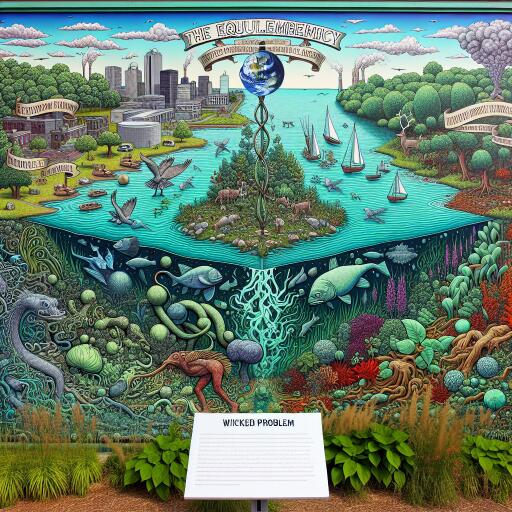
Balancing the nutrient load in Lake Erie is a ‘wicked problem’
Lake Erie, renowned for its flourishing aquatic life, is currently grappling with complex environmental challenges. Intriguingly, existing regulations aimed at curbing nutrient inflow from agricultural practices into the lake might be overly stringent for some fish species.
Nonetheless, these stringent measures are projected to sustain healthy fisheries at least until the mid-21st century, factoring in the implications of a warming climate, according to recent research spearheaded by the University of Michigan.
Don Scavia, a respected professor emeritus at the School for Environment and Sustainability, elucidates, “Adopting these targets now aligns with long-term benefits.” Although the limits may appear stringent presently, Scavia insists that they should remain in place given the protracted timeline required for ecological changes to materialize.
This groundbreaking study is a collaborative endeavor involving scientists from both America and Asia. The team synthesized climate forecasts, historic fishery records, and sophisticated mathematical models to analyze the lake’s nutrient dynamics. An essential metric for water quality examined by the researchers is the oxygen concentration within the lake’s depths.
These elements interact to reveal a multifaceted scenario. Indeed, simply reducing nutrient inflows enhances water quality; however, this does not directly translate to benefits across all fish species inhabiting the lake.
Scavia highlights inherent tradeoffs, noting that with ongoing global warming, temperature will supersede nutrient levels as the dominant factor influencing oxygen concentrations in bodies like Lake Erie and other similar ecosystems globally.
Does this complexity consign us to a stalemate? Far from it. It merely underscores the necessity for adaptable management strategies amid changing environmental landscapes.
Given the absence of a universal solution for ecosystem management, flexibility is crucial to adapt to evolving situations. Environmental stewardship often refers to this as a “wicked problem.”
The nutrients employed in fertilizers, crucial for agricultural productivity, become problematic upon entering water bodies. These nutrients act as a smorgasbord for microorganisms, such as algae and cyanobacteria, triggering algal blooms in regions like Lake Erie, the northern Gulf of Mexico, and Chesapeake Bay. When these blooms decay, they create hypoxic, or low-oxygen, conditions detrimental to numerous fish species.
While cyanobacteria proliferate in nutrient-dense waters, they simultaneously support the growth of plankton, essential for the diets of larger fish.
Stuart Ludsin, an expert at Ohio State University’s Aquatic Ecology Laboratory, notes the adverse impact of hypoxic conditions on cold-preferring species like lake whitefish in Lake Erie. Conversely, species like the yellow perch thrive in nutrient-abundant environments, as pointed out by Ludsin.
The current nutrient conditions are also favorable for walleye populations. However, finding the optimal balance between advancing water quality and maintaining robust fish populations is a fluctuating target.
The aim is not to exacerbate pollution to benefit fisheries but to identify nutrient levels that harmonize water quality objectives while supporting the diverse fisheries of the lake.
Anna Michalak, associated with Carnegie Science, advocates for a systems-level approach involving managers and stakeholders in determining these levels. Michalak has collaborated with Scavia for over a decade, studying aquatic ecosystems like Lake Erie. She stresses that choices promoting one aspect, such as water quality, might incur costs on another, like fisheries.
Professor Dan Obenour from North Carolina State University suggests the study serves as a blueprint applicable to other ecosystems. Obenour emphasizes the importance of adaptable strategies using the climate-hypoxia model, which has shown durable accuracy over extensive timelines.
Climate change adds further complexity to nutrient management challenges in Lake Erie and similar systems. As global temperatures rise, altered precipitation patterns increase the likelihood of severe rainfall events, introducing more nutrients into waterways. This exacerbates existing management challenges, necessitating nimble solutions.
Scientists are now embedding climate resilience within their models to predict future transitions in aquatic ecosystems more accurately.
With this enhanced understanding, policymakers and stakeholders can forge strategies that proactively accommodate forthcoming environmental fluctuations.
Advancements in technology and data analytics significantly contribute to shaping impactful environmental policies. Utilizing satellite imagery and real-time sensor data, researchers achieve unprecedented precision in tracking nutrient inflows and algal bloom development.
These technological innovations enable swift water quality assessments, facilitating the creation of precise mitigation strategies.
As environmental challenges grow in complexity, combining advanced science with assertive policy measures provides hope for sustaining Lake Erie’s ecological equilibrium and conserving its priceless natural assets.
Indeed, pinpointing the optimal management solution is arduous. Yet, even post-consensus, future changes will necessitate ongoing reassessment.





Leave a Reply